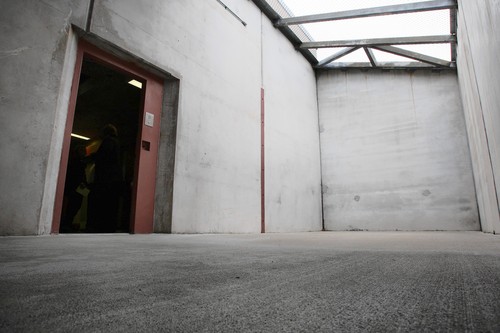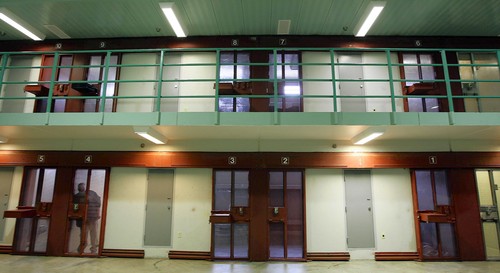If you know anything about the United States’ spectacularly f*cked up and viciously racist prison system then you’ve possibly wondered, from time to time, how one might go about “changing things” when activism involving alleged criminals has historically been too stigmatized to gather significant mainstream attention.
Well, two weeks ago with the final shuttering of the notorious Tamms Correctional Center in Illinois, there is a new hope on the horizon that activism and publicity can actually make a difference. Tamms, a 500-bed supermax facility, keeps its inmates in solitary confinement, where they spend 23 hours a day in 7-by-12-foot cells. There’s no mess hall, library, classroom or yard at Tamms.

But, although the conditions at Tamms are particularly horrifying, it’s only one of many American Supermaxes employing the controversial “solitary confinement” technique that many (including The United Nations International Covenant on Civil and Political Rights) consider a violation of the Eighth Amendment, which forbids “cruel and unusual punishment.”
Solitary confinement actually started out as a nice, well-intentioned Quaker thing — they thought isolation would give criminals a chance to contemplate what they’d done and do some spiritual soul-searching, as Quakers are wont to do. But throughout the 19th century, reports of the mental health problems sustained in solitary discouraged the strategy from becoming popular or common.
The road to our current Supermax Prison boom began in 1983 when two corrections officers were stabbed to death by inmates in two different incidents at a high-security prison in Marion, Illinois. The facility responded by going into “permanent lockdown,” from which they began transforming the place into a “control unit” prison. (According to at least one inmate kept in the Marion prison at that time, inmates were abused and essentially tortured throughout this process.)
In response to a call for more secure prisons from Norman Carlson, then-director of the Federal Bureau of Prisons, “ADX Florence” was constructed in Florence, Colorado, and met Carlson’s recommendation to isolate inmates who “show absolutely no concern for human life” from correction officers and other prisoners. By 2005, 44 US states had built their own wildly expensive Supermaxes, prisons made specifically to house “violent or disruptive inmates” in isolation. Many inmates from the Marion prison were transferred to the Supermax, The Tamms Correctional Center.
2005 was also the last time the government took a full-scale count of inmates in solitary, from which they determined that approximately 80,000 inmates were being held in isolated confinement in the United States on any given day (follow that link for more discourse around the origin and meaning of that number). At least 25,000 inmates are kept in solitary in high security Supermaxes. Sometimes inmates under the age of 18 are held in solitary confinement, which is possibly the worst idea of all time. Many are kept there for months or years or even decades — Pelican Bay’s currently got an inmate on his 43rd year. Inmates are often deprived of educational or therapeutic programs, reading materials, sunlight, noise, human contact and communal religious services. Their one hour outside of their cell is spent in a confined outdoor “exercise” space void of other human beings.

Although Tamms is an all-male facility, it’s crucial to note that women in solitary confinement face special challenges. “Solitary confinement makes women more vulnerable to staff sexual assault since no one can see what is happening,” says author Victoria Law in an interview in PM Magazine. “Women are punished for behaviors that violate gender norms, behaviors such as spitting or cursing or not following orders, behaviors that men are not punished for. This is also why women are sent to segregation when they report sexual misconduct or engage in sexual activity; they’re violating what we, as a society, see as ‘good girl behavior.’”
As psychiatrist Stuart Grassian pointed out in a 2007 TIME Magazine article about the mental health risks of solitary confinement: “We’re taking criminals who are already unstable and driving them crazy.” Psychology professor Craig Haney studied the SHU population of Pelican Bay in California and says that “there hasn’t been a single study of individual solitary confinement that didn’t show negative psychiatric symptoms after ten days.” If an inmate is ever released from solitary into the world, they face a severe uphill battle that’s more likely to lead into a deep gully of despair, with a destructive impact on their friends, family and community, than it is towards any semblance of a new life. In other words: “solitary confinement has a detrimental effect on inmates’ psyches and is likely to make them more aggressive, uncontrollable and, upon release from prison, more likely to reoffend and be reincarcerated.”


Many Americans still assess solitary by its most well-known inmates — ADX Florence houses heaps of Al-Qaeda operatives as well as famed Al-Qaeda conspirator Zacarias Moussaoui, Ted Kaczynski (“The Unabomber”) and Oklahoma City bomber Terry Nichols as well as members of prominent gangs, drug cartels, cults, The Ayryan Brotherhood and Neo-Nazi groups.
But even for those people out there who believe solitary is a reasonable punishment for those crimes and many other severe felonies, it’d be impossible for them to justify why we’re also sending non-violent offenders and alleged criminals into solitary for profoundly ridiculous reasons, such as inmates in Pelican Bay kept in solitary because prison staff believes — with proof that’s shaky at best and entirely fabricated at worst — that said inmate is in a prison gang. “Proof” has included possessing a picture of Malcom X or a copy of Machiavelli’s The Prince. Solitary Watch reports that these days, inmates are placed in solitary for things like possessing contraband, testing positive for drug use, ignoring orders, or using profanity, as well as because they’re gay, transgender, Muslim, have a mental illness or report rape or abuse by prison officials. David Tulam, whose case is not unusual, spent 18 years in solitary in New Jersey State Prison — the crime that landed him in prison in the first place was “trying to rob a gun store,” Tulam got tossed into solitary for allegedly plotting to harm a prison officer.
In the American Friends Service Committee’s 2003 Report “The Prison Inside The Prison: Control units, Supermax Prisons, and Devices of Torture,” it is noted that according to independent monitoring organizations like Human Rights Watch and accounts received by AFSC, “the decision to isolate the prisoner may be made without any formal proceeding, and the period of isolation most often has no defined endpoint… because confinement in a control unit is determined by prison authorities rather than the courts, prisoners’ constitutional right to due process of law is not recognized.”

Many wrongfully accused and wrongfully imprisoned innocent people have been held in solitary. For example:
Damien Echols of the “West Memphis Three” was recently released after spending 10 years in solitary in an Arkansas Supermax for a murder he didn’t commit.
Julie Rea was wrongfully imprisoned on the charge of murdering her son and spent 3 years in solitary before her exoneration in 2006.
Herman Atkins spent 11 years in prison, including 16 months in solitary confinement, for a rape and robbery he didn’t commit before his exoneration in 2000.
Robert Dewey spent 17 years in prison for a murder he didn’t commit, during which he was sent to solitary for failing a drug test — he’d been given Tylenol 3 following a back surgery, which officers assured him wouldn’t show up on the test (it did).
Nicholas James Yarris spent 23 years in solitary confinement on murder, rape and abduction charges, before his exoneration by DNA testing in 2003.
Darrell Cannon was tortured by the cops who picked him up on a murder he didn’t commit in 1983. Chicago Police Commander Jon Burge, linked to other incidents of torture, as in charge. Cannon spent 24 years wrongfully imprisoned, including 9 years in solitary confinement in Tamms.

Poor people are often unable to secure the legal representation and other resources they need to avoid a wrongful conviction or a sensical sentence. People of color face a labyrinth of institutionalized discrimination regardless of the legal counsel they secure. Racism is a controlling force behind every movement and decision in the criminal justice system, from arrest to conviction and beyond, leading to dramatically higher incarceration rates and harsher sentences for people of color than white people committing the same crimes. Though precise numbers on the racial makeup of solitary confinement inmates aren’t available, it’s safe to assume that like other extreme punishments, solitary confinement is disproportionally doled out to people of color.

Which brings us back to Tamms, which opened in 1995 as a 200-bed minimum-security facility and expanded in 1998 to feature a 500-bed Closed Maximum Security Unit. According to an in-depth investigative piece on The News-Democrat, despite Tamms’ designation as a place for the “worst of the worst” to stay for a year in solitary and then relocate to a new prison, 55 inmates had been there for more than ten years and 39 of the prisoners transferred there in 1998 remained in solitary in 2012. Furthermore, the majority of the inmates weren’t “the worst of the worst” and many were mentally ill. Mentally ill inmate Anthony Gay is serving 97 years for throwing feces. As aforementioned, mentally ill inmates should never be placed in solitary confinement, and Tamms’ continued record of doing so is one of activists’ primary objections to how the prison operates.
The Uptown People’s Law Center have been campaigning for the closing of Tamms since it opened. The documents gathered to make their case are available online, and include gut-wrenching testimonies from nearly two thirds of Tamms’ inmates. There’s also research by psychologists, sociologists and criminal justice experts proving Tamms’ ineffectiveness as an absolute end to prison violence as well as the counterproductive psychological effects of solitary on prisoners. Those against the closure of Tamms cited concerns about job loss (the guard’s union AFSCME was the most powerful opposition to the Tamms’ closure) — after all, there are more guards than inmates at Tamms, with the staff there collecting a combined annual payroll of about $18.7 million dollars. The sparsely-occupied facility requires $85,000 a year just to guard one prisoner (excluding overtime), compared to the $15,000-$24,000 cost incurred by inmates in other Illinois prisons.

The first group to organize around Tamms, The Committee to End the Marion Lockdown, got started before it was even built, and they were followed a group founded by attorneys Jean Snyder and Jim Chapman, which eventually became the Tamms Committee. The Tamms Committee, alive until 2006, advocated and visited individual prisoners and held meetings to educate family members. In 2008, Tamms Year Ten came along as an organizing campaign that brought together dozens of legislators and some 70 organizations to work for reform legislation. It was an outgrowth of the Tamms Poetry Committee, which had direct lineage from the Committee to End the Marion Lockdown. As noted by the ACLU, “Once the families started meeting together, it became clear that the problem wasn’t the men at Tamms; the problem was that Tamms was torture.”
In 2008, the ten-year anniversary of the supermax’s opening, Tamms Year Ten launched a legislative and media campaign. By that time, one-third of Tamms’ current inmates had been in isolation for the entire decade. It took only 12 months of dedicated, intense organizing, the introduction of legislation and numerous meetings to get to Governor Quinn saying that, “It is a problem that I take seriously.” He introduced a new IDOC director and tasked him with the review and evaluation of the Tamms Supermax, and in September 2009, he presented his reform plan. It included “any allegation of inhumane treatment at Tamms will be investigated.” Tamms Year Ten has been lobbying in Springfield for five years as well as holding work meetings, exhibitions, protests, actions, lobby days and holiday card mailings.
The “I AM A MAN” signs employed by Tamms Year Ten were inspired by the Civil Rights Movement — they were first used in 1968 by the sanitation workers in Memphis Martin Luther King Jr. was supporting when he was killed. Tamms Year Ten added “I AM A MOM” signs and used them at rallies, hearings, and a march protesting AFSCME on April 4th, the anniversary of MLK’s death. Photographs featuring portraits of formerly incarcerated were delivered to legislators and displayed in the Illinois statehouse during final budget negotiations.

The Uptown People’s Law Center litigated a class action to aid Tamms prisoners and on July 20, 2010, the District Court revealed its opinion: every prisoner who’d been transferred to Tamms had been denied a hearing and due process and therefore all must be given not only a hearing, but also a written explanation of why they’d been sent to Tamms at all. As hearings proceeded, more inmates were transferred out. In February 2012, Governor Patrick Quinn announced a budget plan that included closing the Tamms Correctional Center, and on January 4th, 2013, the facility closed its doors for good. The governor wants the money saved from closing Tamms to go towards child protective services, and 270 of their 300 employees have accepted other positions within the Department of Corrections or other state agencies. The remaining 30 employees are pursuing different lines of work.
The Uptown People’s Law Center proudly announced last week:
“Tamms officially closes its doors today, first and foremost because the men sent there did not disappear. Rather than buckle under the extreme psychological pressure of solitary confinement, they banded together, fought back, and reached out and educated and organized their families and friends.”
The lawmakers who fought for this were motivated by moral issues, but there’s been media focus on the financial benefits, too. From the ACLU National Prison Project:
Closing Tamms also means that state lawmakers are beginning to recognize that the exorbitant costs associated with “supermax” facilities are an unjustifiable drain on public resources. According to the Illinois Department of Corrections, “[o]ne of the reasons Tamms was chosen for closure is because it is by far the most expensive facility to operate” – indeed, closing Tamms will mean millions of dollars in savings for the state and its taxpayers. Data shows that Tamms was the least cost-effective of all Illinois’ facilities. Research from around the country tells the same story as in Illinois: solitary confinement is the most expensive form of incarceration and it neither deters violent behavior in prisons nor prevents recidivism.

It’s a significant victory and hopefully a hint of things to come. The ACLU says that the call for change is gaining traction nationwide due to “growing budget deficits, costly litigation arising from unconstitutional treatment, and the public’s objection to inhumane conditions.” They cite several other recent achievements, highlighting the following:
- The Maine Department of Corrections cut its “supermax” population by over fifty percent and provided prisoners expanded access to programming and social stimulation.
- Over the last few years, Mississippi reduced the “supermax” population of one institution from 1000 to 150 and eventually closed the entire unit.
- In the last year, Colorado reduced the number of prisoners in solitary confinement by 36.9% and recently announced the closure of a 316-bed “supermax” facility, which is projected to save the state $4.5 million in Fiscal Year 2012-13 and $13.6 million in Fiscal Year 2013-14.
It’s been a huge year for this particular cause, actually.
In April 2012, Amnesty International issued a report expressing its concerns about “cruel isolation” conditions in Arizona’s Maximum Security Prisons. In June, The Supreme Court began its first-ever review of solitary confinement. In October, Human Rights Watch called upon the nation to abolish the use of solitary confinement for offenders under 18. In December, the ACLU in New York City launched a federal lawsuit challenging New York prison official’s system-wide policies and practices governing solitary confinement. This month,Washington announced its intent to re-examine their policies and move away from solitary confinement and California started emptying their solitary confinement cells (perhaps this scathing Amnesty International Report exposing “Severe, Inhumane Solitary Confinement Conditions for 3,000 California Prisoners” had an impact). That’s some progress.
But at a U.N Prisoner’s Rights Meeting in December, the U.S. balked at proposals to limit the amount of time spent in solitary or to ban solitary for kids, pregnant women, and mentally ill persons. This week, it’s officially been 11 years since the first prisoner arrived at Guantánamo and it remains open. I’ve personally found it astounding that over the past few weeks, patriots have clung to an infinitely broad and absolute authority of the Second Amendment while failing to acknowledge our government’s complete disregard for the eighth.

What happens next remains to be seen. In the past year alone the solitary confinement issue has garnered unprecedented press attention. Mother Jones‘ article “Solitary in Iran Nearly Broke Me. Then I Went Inside America’s Prisons” was a wildly popular must-read from December, and other recent press includes The New York Times’ “Prisoner’s Letters Offer a Window Into Lives Spent Alone In Tiny Cells” and “Prisons Rethink Isolation,” The Nation‘s “Unlock The Box“, The Dart Society’s “The Gray Box” and Solitary Watch‘s “Fortress of Solitude.” (2009’s “Hellhole” is also worth a read, and a 2006 NPR series on Life In Solitary Confinement is excellent.)
Julie Rae, the woman wrongfully imprisoned for three years after her son was murdered by a masked invader, shared the following in a testimony submitted to the Senate Judiciary Subcommittee on the Constitution, Civil Rights and Human Rights in June 2012:
“My earnest prayer is that the men and women who assaulted my mind, body and spirit during this time will come to know love, joy and forgiveness in goodness, rather than the pleasure of the sick and twisted activities they chose at the time… it is my deeper prayer that somehow writing this will place a growing desire in the hearts and minds of those who read it, that they can bring health and change to our jails and prisons and courtrooms and will do so.”

The ACLU has a dedicated section on its website with information about advocacy to stop solitary confinement, including research, news and first-person stories from solitary confinement and a petition. You can also check out The Tamms Year Ten and the Uptown People’s Law Center. For more on how spectacularly fucked up the U.S. correctional system is, the Safe Communities: Fair Sentences page is a place to start.







